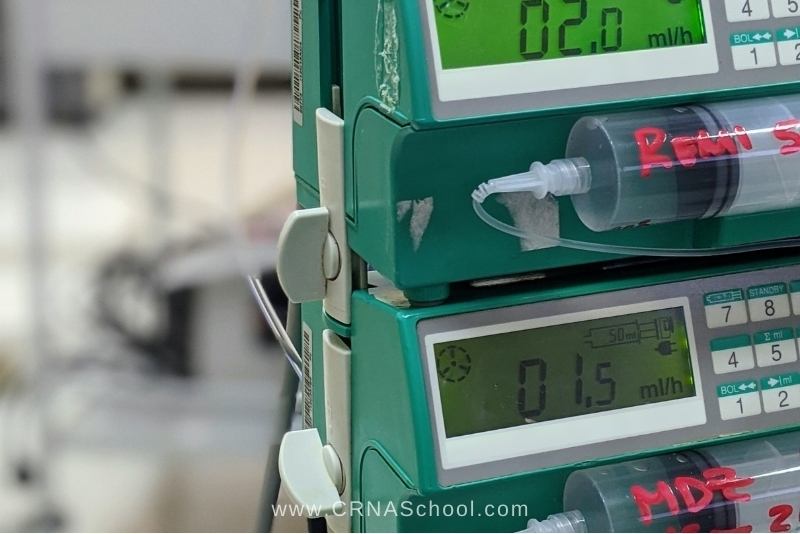The pandemic has created a high demand for a lot of medical jobs. If you’re on the path to becoming a nurse anesthetist, you may have wondered, do nurse anesthetists have high employment rates?
Employment rates for CRNAs are higher than ever and are projected to increase in the years to come. Nurse anesthetist jobs are expected to increase rapidly at the rate of 26% through 2028, far exceeding the average rate for other industries and professions.

The continuing coronavirus pandemic, an aging population, and a need to substitute a huge proportion of retiring health professionals and those who move to other career paths are all anticipated to give nurse anesthetists high employment rates.
Certified Registered Nurse Anesthetist (or CRNA) job vacancies are expected to increase by 17%, with the majority of opportunities in rural communities, inner cities, and other underserved areas. In the next ten years, approximately 3,200 nurse anesthetist jobs will become accessible.

Is Nurse Anesthetist in High Demand?
The demand for certified registered nurse anesthetists (CRNAs) is at an all-time high. According to the Bureau of Labor Statistics, the CRNA specialization will expand by more than 30% over the next ten years.
CRNA certification is a multi-step procedure that takes seven to eight years to complete. To be admitted to a CRNA school, you must be a registered nurse with acute care nursing experience.
Nurse anesthetists are also cost-effective services. They offer high-quality nursing treatment at an affordable cost to their patients. The need for more health care services is being fueled by several reasons, including healthcare legislation and the aging baby-boomer demographic.
What Are Nurse Anesthetists and What Do They Do?
Registered nurses who specialize in anesthesiology and have at least a year of critical care knowledge and a master’s degree, which normally takes two years to complete, are known as Nurse Anesthetists.
Certified Registered Nurse Anesthetists (CRNAs) are expert clinical nurses who securely administer over 40 million anesthetics in the United States each year for clinical, postnatal, and damage care. From surgical intervention to discomfort moderation practices, they prescribe every type of anesthetic, work in every type of practice setting, as well as provide treatment for every sort of medical activity or procedure.
Nurse anesthetists work with doctors, orthopedic surgeons, orthodontists, orthopedists, and other competent medical professionals to administer anesthetics to patients. They are provided a significant level of autonomy and positive regard as advanced practice registered nurses.
Nurse anesthetists can implement particular or regional anesthesia using a variety of intravenous drugs and inhaled gases, allowing doctors to accomplish procedures with next to no pain to the patient. From the chloroform used by the first nurse anesthetists during the Civil War, modern anesthesia has made great strides.

A nurse anesthetist is responsible for a patient’s anesthesia needs before, during, and after surgery or childbirth by:
- Conducting a physical examination
- Taking part in preoperative education
- Being ready for anesthetic administration
- Using anesthesia to hold the patient pain-free.
- Intraoperative anesthesia maintenance
- Supervising anesthesia recovery
- Observing the patient’s rehabilitation from the emergency room to the patient care unit
How to Become a Nurse Anesthetist
A standard route to becoming a CRNA includes earning a four-year BSN, becoming certified and serving as a registered nurse for one to 3 years and eventually enrolling in a two-year MSN program in nurse anesthesia. Other choices involve receiving an associate degree in nursing, gaining licensure and practicing as an RN, and enrolling in an RN-to-MSN program; or undertaking a BSN-to-DNP bridge program.
Depending on the degree sought, the period it takes to become a certified CRNA varies. CRNAs must complete comprehensive studies, including at least 2,000 hours of clinical practice.
CRNAs must be registered nurses (RNs) or advanced practice registered nurses (APRNs) with national qualifications in nurse anesthesia from the NBCRNA. The National Certification Exam (NCE) and the Self-Evaluation Examination are needed for certification (SEE).

1. Obtain a Bachelor of Science in Nursing degree
Earning a Bachelor of Science in Nursing (BSN) degree is the first phase. A bachelor’s degree in nursing requires an average of four years to complete.
2. Obtain your certification as a licensed nurse
The next move after obtaining a BSN is to secure a registered nurse (RN) certificate. To sit for the RN test, you must first hold a bachelor’s degree in nursing.
3. Work as a Nurse in Acute Care
After that, you’ll want to obtain experience in an intensive care environment before applying to a CRNA program. Most CRNA programs enable you to get more than a year of training, but each program has its own set of criteria on what constitutes acute treatment.
Serving in a coronary treatment facility, an emergency department, or an intensive care unit is what most CRNA programs describe as acute care. Since CRNA programs vary, before taking a job in an acute care environment, you can review the criteria of your chosen CRNA schools.
4. Finish CRNA School
It’s time to apply to CRNA schools after you’ve completed all of the above requirements. A nurse anesthetist program will take two to three years to complete, depending on the school.
CRNA schools instruct their pupils both in the classroom and in clinical environments. You must then complete the National Qualification Test after completing your CRNA program.

What Are The Top Paying Industries for Nurse Anesthetists?
Hospitals, which include NPs, nurse midwives, and CRNAs, are the highest-paying profession for APRNs, according to the US Bureau of Labor Statistics (BLS), with a total annual wage of $122,420.
Outpatient medical facilities (median average wage of $118,530), doctors’ offices ($113,190), other clinical professionals’ offices ($112,590), and educational services ($108,790) are other high-paying environments. CRNAs make more money than most APRNs, with an annual income of about $175,000 for nurse anesthetists.
What States Pay the Most for Nurse Anesthetists?
Wyoming has the largest CRNA wages, with workers receiving a mean annual salary of $243,310, according to the BLS, led by Montana ($239,380), Oregon ($234,750), Wisconsin ($233,600), and California ($227,290).
According to the BLS, Texas employs 4,300 CRNAs, followed by North Carolina with 3,190, Tennessee with 2,680, Ohio with 2,450, and Michigan with 2,330. Michigan tops the ranking in terms of nurse anesthetist pay, with a mean annual wage of $194,640, led by North Carolina ($189,060), Ohio ($184,380), Texas ($167,020), and Tennessee ($157,070).
The Bottom Line
Nurse anesthetists operate in many environments, including conventional hospital surgery suites and obstetrical delivery rooms, critical access clinics, ambulatory surgical centers, orthodontists’ clinics, podiatrists’ office spaces, ophthalmologists’ clinics, plastic surgeons’ clinics, and pain relief specialists’ departments, as well as federal, Veterans Services, and healthcare system health treatment facilities. They have a lot of responsibilities and are well paid for them. There is a constant increase in the demand for nurse anesthetists in both rural and urban healthcare setups. As a result, the job opportunities for nurse anesthetists are increasing every year and are predicted to increase even more in near future.
References
- Journal of Professional Nursing, Volume 16, Issue 1, January–February 2000, Pages 47-56, Ph.D., RN, CRNA, FAANWynne R.Waugaman(Associate Professor of Nursing and Assistant Chair of Academic Affairs).
https://doi.org/10.1016/S8755-7223(00)80011-3
- Does the Employment of Physician Assistants and Nurse Practitioners Increase Liability?
Roderick S. Hooker, Ph.D., PA; Jeffrey G. Nicholson, Ph.D., PA; Tuan Le, M.D., DrPH
- Journal of Medical Regulation (2009) 95 (2): 6–16.
https://doi.org/10.30770/2572-1852-95.2.6
- Role Transition After Clinical Nurse Specialist Education, Ares, Terri L. Ph.D., RN, CNS-BC, Clinical Nurse Specialist: March/April 2018 – Volume 32 – Issue 2 – p 71-80 DOI:10.1097/NUR.0000000000000357
- The Certified Registered Nurse Anesthetist: Occupational Responsibilities, Perceived Stressors, Coping Strategies, and Work Relationships, Perry, Tristan Roberts.

